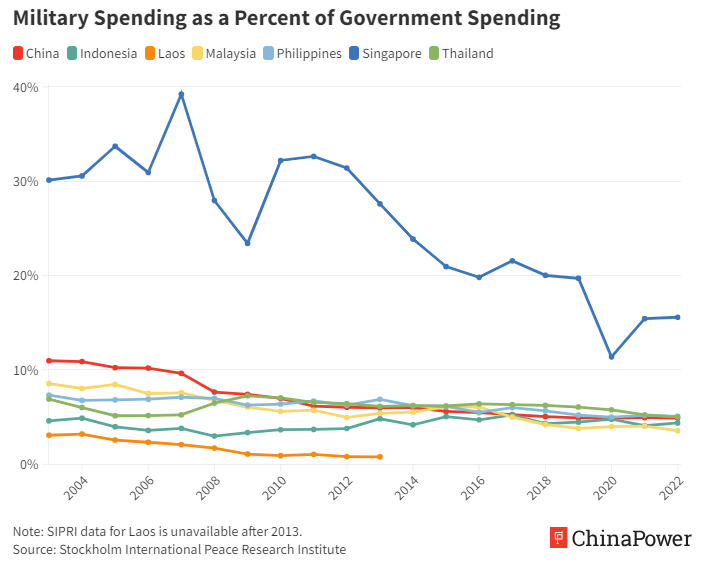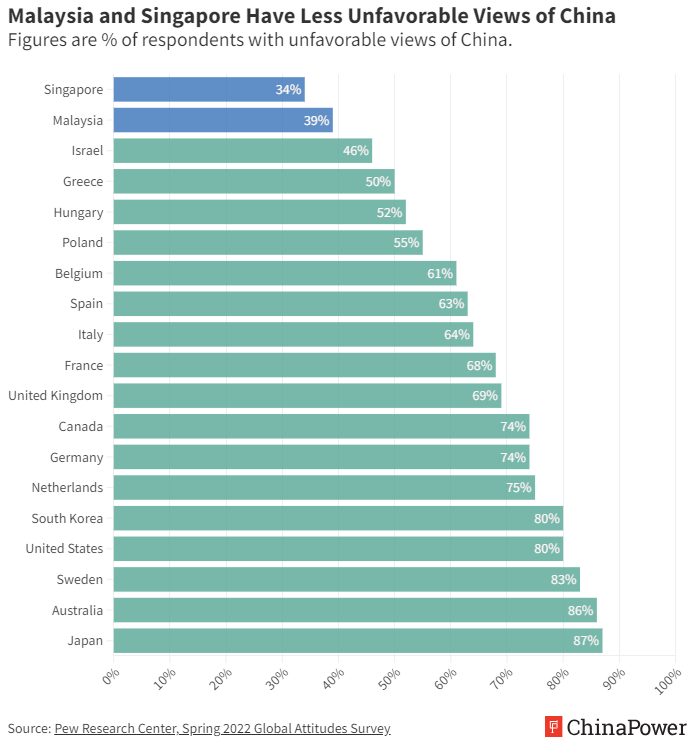Southeast Asia looks at China differently from how the West views China. Rather than fearing or resisting China’s economic and geopolitical rise, countries in the region have mostly taken a pragmatic approach and see China’s rise as strategically and economically beneficial for their regime security. Southeast Asian states are actively increasing their economic interactions with China because they believe that economic security is an indispensable part of their national security as well as Southeast Asia’s comprehensive security. Domestic imperatives of regime survival and legitimacy tied to economic performance are key drivers of regional countries’ policies towards China. A rising China is, therefore, inextricably linked to regional security and domestic stability.
China’s rise is not only an economic opportunity, but also a strategic opportunity for Southeast Asian states to ensure that no single power can dominate the region. An active China allows Southeast Asian states to pursue economic and strategic diversification, preventing them from becoming overly reliant on the United States or other major powers. At the same time, it provides a strategic rationale for Southeast Asian states to keep the United States in the region, assuaging concerns of abandonment.
Strategic Diversification
There are few signs that the region is balancing against China despite the latter’s aggressive
foreign policy, especially in the South China Sea. Southeast Asia’s military spending has declined or remained relatively stable for more than two decades, suggesting that most regional states do not expect an armed conflict involving them even though they are worried about Chinese coercion in other forms.

There are two key reasons for this. First, few Southeast Asian states are willing to make the costly domestic and economic trade-offs required to significantly bolster their military capabilities to ward off apparent Chinese aggression. Second, most Southeast Asian states do not view China as expansionist or a direct military threat. Even those with maritime disputes with China, namely the Philippines and Vietnam, have seen their relations with China wax and wane over time, depending on leadership priorities.
Thus, Southeast Asian states are not engaging in all-out deterrence or hard military balancing in response to China’s rise and are unlikely to do so in the foreseeable future. Differences are usually resolved through multilateral dialogue and diplomacy, which is anchored by the Association of Southeast Asian Nations (ASEAN).
However, the region is not embracing China’s rise without qualms. Rather, it is engaging in strategic diversification and keeping all options open. Even Laos, which is usually seen as a Chinese client state, engages in strategic diversification whenever there are alternatives open to it—including economic ties with Thailand, political patronage from Vietnam, and development aid from Japan. Southeast Asian states choose to align their policies with major powers on an issue-by-issue basis. Considerations of national interest drive their choices.
Regime Survival and Legitimacy
The conventional narrative is that Southeast Asian states possess a relatively limited and constrained set of options for responding to superpower rivalry, especially as China’s military and economic influence surges. A hegemon’s authority, however, cannot be realized through force alone. It is costly to maintain over time and often undercuts a state’s ability to wield actual influence. A more enduring form of
leadership and influence derives from the validation and acceptance of other states.
Whether Southeast Asian governments affirm China’s (or the United States’s) leadership requires an exploration of how domestic politics within regional states inform that affirmation. Many important factors influence a Southeast Asian government’s foreign policy. For instance, how do historical legacies and cultural affinities and differences with external powers affect Southeast Asian decision making? How do considerations of regime legitimacy and political fragmentation in domestic politics shape their foreign policies?
To answer these questions, Yale-NUS College and the Lee Kuan Yew School of Public Policy convened a conference in Singapore in March 2023 with scholars from six Southeast Asian countries (Indonesia, Laos, Malaysia, the Philippines, Singapore, and Thailand). The scholars presented papers which were published in a special issue of Contemporary Southeast Asia in April 2024. The articles reveal each of the six countries’ complex domestic considerations with respect to China and the United States and the strategies they use to maintain a balance between the two. By examining how foreign policy is shaped at the domestic level, the rationale for Southeast Asia in adopting strategic diversification externally becomes much clearer and nuanced. More importantly, uncovering how domestic factors vary across time and space allows for mapping the changes and continuities in Southeast Asian states’ strategies toward the great powers.
Interestingly, the rationale behind these decisions is remarkably consistent across the Southeast Asian states in the study: they are primarily driven by the imperatives of political survival and regime legitimacy, and the search for economic security leads these countries to expand economic cooperation with China.

There are, however, limitations to how far leaders of some of these countries can pursue economic ties with China. Indonesia, the Philippines, and Laos, for instance, are constrained by public opinion. Party politics, ethnic politics, and social fragmentation are also factors in countries like Malaysia, Singapore, and Thailand that account for shifts in their policies towards China and the United States. The decisions that successive incumbent governments of these countries make are aimed at shoring up their legitimacy and survival as they maneuver around these domestic challenges.
Outlook
These imperatives of regime survival drive Southeast Asian states to not only adopt strategic diversification but also to cleave to ASEAN. Southeast Asian states prefer an ASEAN-centered regional order. Such a preference is designed for regime security stemming from Southeast Asian states’ vulnerabilities as small, emerging nation-states. However, domestic developments in the medium to longer term may draw countries to lean closer to China even as the regional order remains ASEAN-centered. In the foreseeable future, there are three trends in the region that warrant watching.
First, Southeast Asian bureaucrats, diplomats, and ordinary citizens are increasingly
educated and trained in China through scholarships provided by the Chinese central government, subnational governments and state-owned enterprises. How does their experience with a prosperous and resilient China impact their views on China, particularly in comparison to parts of the West that seem to be polarized and paralyzed by ethnocentrism and identity politics?
Second, societal and political pluralization and fragmentation in Southeast Asian countries allow Chinese entities to influence domestic developments. Beijing often invests in projects that are priorities of local elites whom they seek to cultivate. There have been occasions—although rare—during which Chinese ambassadors have stumped for candidates in local elections. Chinese entities have also bought up media platforms in some Southeast Asian countries, and business groups are known to exert pressure on their governments to seek closer ties with China.
Third, cultural affinities with China draw some parts of the region closer to China. A Pew Research Center survey in 2022 showed that in Singapore and Malaysia—where there are substantial ethnic Chinese populations—people tend to have less unfavorable views of China. The Chinese Communist Party’s united front bodies are also active among ethnic groups in the region, reflecting President Xi Jinping’s call to “all the sons and daughters of the Chinese nation at home and abroad” to contribute to China’s great rejuvenation.

Getting Southeast Asia right requires being more attuned to how domestic politics influences foreign policy options in the region. Southeast Asian states are often dismissed as punching below their weight. Changes in their foreign policy orientation may not necessarily lead to tectonic shifts in geopolitical rivalry, but if Beijing (and Washington) is keen to expand its leadership role in the region, it will need to pay closer attention to the motivations, priorities, and preferences of Southeast Asian states.
Selina Ho is Assistant Professor in International Affairs and Co-Director of the Centre on Asia and Globalisation at the National University of Singapore’s Lee Kuan Yew School of Public Policy.
Chin-Hao Huang is Associate Professor of Political Science at the National University of Singapore, with appointments in both the Lee Kuan Yew School of Public Policy and Yale-NUS College.
This article was first published on
ChinaPower on 8 July 2024.